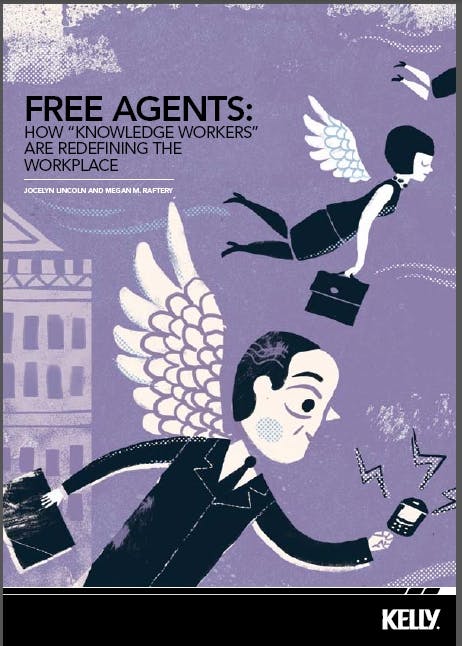The number of “free agent” workers has nearly exploded in the last three years, and now 44 percent of working Americans describe themselves that way.
A Kelly Services survey — titled Free Agents: How “Knowledge Workers” are Redefining the Workplace — says economic necessity, the desire for more freedom and flexibility, and age have driven up the number of workers not tied to a single company for their livelihood.
It’s a dramatic change from 2008, when Kelly’s survey found 26 percent of workers describing themselves as free agents.
Also fueling the rise is the increasing reliance of American business on contingent and contract labor, say the authors of a whitepaper detailing the results. Companies, note authors Jocelyn Lincoln and Megan M. Raftery, “can scale up and down faster and easier by adopting more flexible workforce strategies.”
Lack of work driving the increase in free agency
A significant driver is the economy. Respondents to the 2011 survey were twice as likely as their counterparts in 2008 to say they became free agents because they were laid off or couldn’t find another job.
That suggests, the authors say, that as recovery occurs, some of the newly minted free agents will return to a traditional employee role. However, “the trend toward more free agents is still very strong and is increasing worldwide. Accounting for differences in legislative frameworks and social and cultural norms, we estimate that the global free agent population is at least 20 – 30 percent of the entire workforce, and growing.”
 Recently, USA Today wrote about the phenomenon of well-established professionals abandoning comfortable jobs to pursue their own interests. “Employees bid goodbye to corporate America” chronicled several workers, including two recruiters, who quit to follow their own path.
Recently, USA Today wrote about the phenomenon of well-established professionals abandoning comfortable jobs to pursue their own interests. “Employees bid goodbye to corporate America” chronicled several workers, including two recruiters, who quit to follow their own path.
As the Kelly Services report makes clear, the move by knowledge workers to  freelancer, contractor, consultant, entrepreneur or other type of free agency is not a generational issue. Gen X workers saw the biggest increase in self-described free agency.
freelancer, contractor, consultant, entrepreneur or other type of free agency is not a generational issue. Gen X workers saw the biggest increase in self-described free agency.
In the 2008 survey, 18 percent of the Gen X workforce so described its status. Now, 38 percent do. That’s a 111 percent increase in just three years, far ahead of the 81 percent rise among Baby Boomers and the 74 percent increase for the Silent Generation, all of whom have now reached retirement age.
What does this mean for business?
Numerically, the Boomers and older workers account for the lion’s share of the free agent population. Together, they comprise two-thirds of all free agents, making the free agent group highly experienced and well educated, the authors write, noting:
More than one-third of all free agents have earned a master’s degree or higher, and compared with traditional employees, more free agents (77 percent compared to 62 percent for traditional employees) possess technical or professional skill set.”
What does this trend mean for American business?
It means there’s a huge pool of available talent in nearly every discipline and industry for employers to tap. But it’s not automatic. Besides knowing how to reach these free agents, businesses need to understand what it is they want. For some, that demands a change in traditional practices.
Write Lincoln and Rafferty, “Organizations have to first learn how to adapt and integrate this flexible workstyle into their business processes and current company culture. This means forgoing traditional perceptions of employment.”
Money just one factor for free agents
For the workers, money is only part of the equation. The Kelly survey found it’s the type of project and quality of work that most interests free agents, especially those with more experience and maturity. The third factor, after the nature of the job and the money, is the reputation of the company.
For companies wanting to take advantage of the free agency trend, the authors make these recommendations:
- Ensure that free agents are included in your overall workforce strategy;
- Know how you are currently using free agents.
- Evaluate departments, positions, and projects to see how they would benefit from free agent talent.
- Understand the importance of your employer brand.
- Develop options for current employees.
- Understand the importance of properly classifying free agent workers.
- Evaluate your workforce solutions partner.
